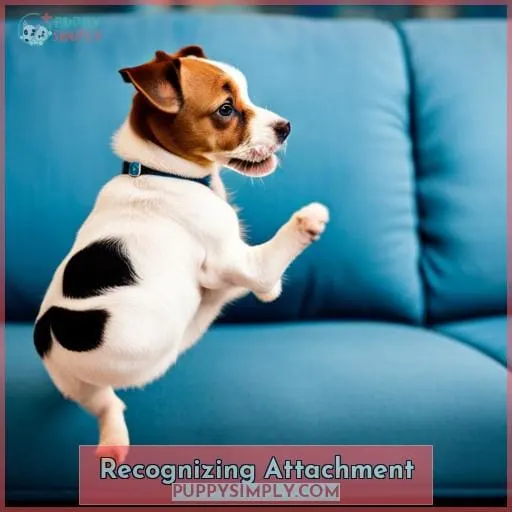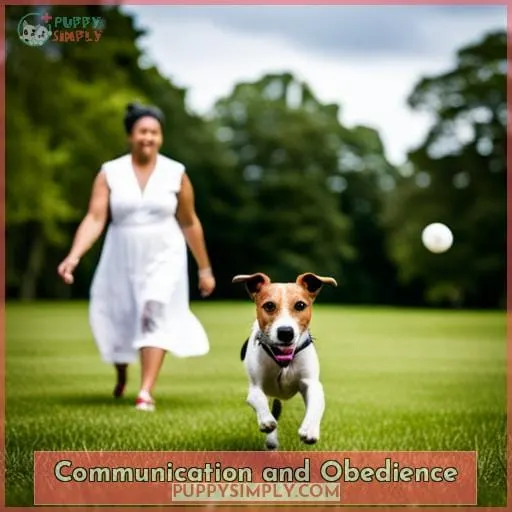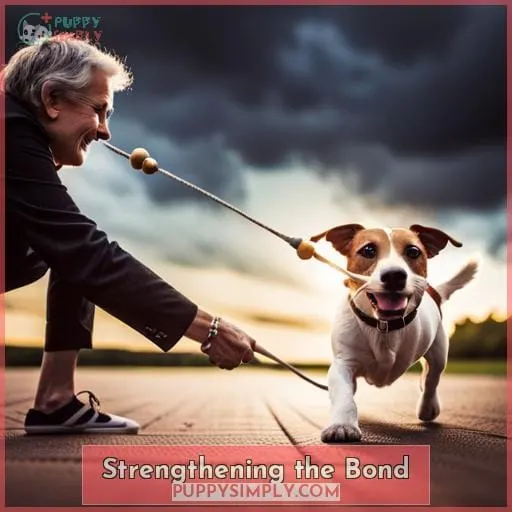This site is supported by our readers. We may earn a commission, at no cost to you, if you purchase through links.
 Ever wondered if your energetic Jack Russell has a soft side?
Ever wondered if your energetic Jack Russell has a soft side?
In Decoding Jack Russell Attachment: Signs, Loyalty, and Bonding, we unravel the mystery.
These spirited terriers aren’t just hunters; they’re loyal companions.
Dive into the world of canine connection as we explore signs of attachment, loyalty cues, and the art of bonding with your Jack Russell.
Discover the key to forging a lasting and affectionate relationship with your four-legged friend.
Table Of Contents
- Key Takeaways
- Signs of Jack Russell Attachment
- Loyalty in Jack Russells
- Possessiveness in Jack Russells
- Building Attachment
- Expressing Affection
- Recognizing Attachment
- Communication and Obedience
- Expressing Happiness and Excitement
- Bonding Through Scent and Possessions
- Strengthening the Bond
- Frequently Asked Questions (FAQs)
- How can I prevent possessive behavior in my Jack Russell?
- Are Jack Russells suitable for families with young children?
- Can Jack Russells form attachments with multiple people in the household?
- What are some common signs of attachment in Jack Russells?
- How can I strengthen the bond with my Jack Russell through scent and possessions?
- Conclusion
Key Takeaways
- Jack Russell Terriers are loyal dogs that bond with their owners.
- They are protective of their families and can be aggressive towards strangers.
- Early socialization and training is important to help them develop good habits.
- Jack Russell Terriers need a lot of exercise and attention to stay happy and healthy.
Signs of Jack Russell Attachment
If you’re wondering whether your Jack Russell has formed a deep attachment, keep a keen eye on their behavior.
Maintaining direct eye contact is a significant indicator, showcasing trust and love.
Additionally, seek physical affection, observe their calm body language in your presence, notice if they carry your belongings, and gauge their responsiveness to commands.
These cues collectively unveil the unique ways in which Jack Russells express their loyalty and attachment, providing a nuanced understanding of their affectionate nature.
Eye-contact
When observing a Jack Russell’s attachment, one key indicator is their regular eye contact with you, signifying a deep connection and trust.
Physical Affection
Physical affection, such as cuddling, petting, and licking, demonstrates a strong bond with your Jack Russell.
They may also return to your side, snuggle, and groom you.
Calm Body Language
Calm body language is a sign of a strong bond between you and your Jack Russell Terrier.
- Return to your side relaxed and confident
- Lean against you contentedly
- Greet you with a friendly wagging tail
Carrying Owner’s Items
Your Jack Russell may carry your shoes to:
Show affection
Pack mentality
Scent marking
Comfort
Security
Return to your side to snuggle
Responsive to Commands
A sure sign of a strong attachment is when your Jack Russell is responsive to your commands.
- Eager to please
- Follow instructions
- Obey first command
- Respond promptly
- Obey consistently
Loyalty in Jack Russells
Jack Russells are extremely loyal to their owners.
They’ve strong protective instincts and can discern between those who love them and potential threats.
While they aren’t recommended for households with toddlers, their loyalty is evident through their barking at perceived threats and curiosity about people in the owner’s life.
Protective Instincts
When it comes to the loyalty of Jack Russells, their protective instincts are a strong indicator of their unwavering devotion to their owners.
They’ll protect you against:
- Strangers
- Other animals
- Dogs
- Children
- Other people
Discerning Threats
Jack Russells have strong protective instincts and can discern between those who love them and potential threats. Their territorial nature, hunting instincts, and possessive behavior make them wary of perceived threats.
They may bark or display aggression towards unfamiliar individuals to protect their loved ones.
Not Recommended for Toddlers
Owning a Jack Russell Terrier may not be recommended for households with toddlers due to their protective nature.
They may be unpredictable, high-energy, and have a strong prey drive.
They may be difficult to train and may be aggressive.
Evident Loyalty Behaviors
Not recommended for toddlers, Jack Russells display loyalty through:
- Barking at perceived threats
- Curiosity about people in your life
- Carrying your shoes
- Returning to your side
- Snuggling with belongings.
Possessiveness in Jack Russells
Jack Russells are known for their possessiveness, which can stem from their protection instincts and territorial issues.
Signs of possessiveness include growling, whining, or even aggression.
Early training is crucial to manage possessive and protective behavior.
Protection Instincts
Possessiveness in Jack Russells may stem from:
- A desire to protect you.
- Jealousy over sharing your attention.
Avoid adopting two same-gender Jack Russells to prevent dominance conflicts.
Territorial Issues
- Possessiveness in Jack Russells may stem from a desire to protect you or jealousy over sharing your attention.
- Signs of possessiveness include:
- Growling, whining, or showing aggression when separated
- Resource guarding, such as food bowls
- Guarding territory or other dogs
- Territorial aggression towards other animals
Signs of Possessiveness
Do you ever wonder if your Jack Russell is being possessive? Signs of possessiveness include:
- Growling
- Whining
- Attacking
- Guarding
- Jealousy
Early Training Importance
To address possessiveness in Jack Russells, it’s crucial to emphasize the importance of early training.
Obedience and socialization from a young age lay the foundation for a well-behaved and attached terrier.
Consistency, positive reinforcement, and early experiences shape their behavior and create a strong bond with their pet owner.
Building Attachment
Building a strong attachment with your Jack Russell involves:
- Working and interacting with them
- Providing attention to their needs
- Regular interaction through play, training, and exercise
Early experiences and socialization during the puppy stage also play a vital role in shaping a lifetime bond.
Working and Interacting
Working and interacting with your Jack Russell strengthens the bond.
- Provide physical affection, attention to needs, and regular interaction.
- Obedience training, recall, and play are also essential.
Early Experiences
The first six months are crucial for forming a lifetime bond with you.
Early socialization, positive reinforcement, crate training can help improve your bond.
Attention to Needs
Providing physical affection frequently strengthens the bond.
Here are 4 ways to show your Jack Russell you care:
- Play
- Exercise
- Training
- Obedience
Regular Interaction
In addition to providing attention to your Jack Russell’s needs, you can build a strong attachment through:
- Play
- Training
- Exercise
- Obedience
Expressing Affection
Expressing affection is an important aspect of building a strong bond with your Jack Russell Terrier.
Despite their energetic nature, they’ve a soft and loving side that they express through various behaviors.
Accepting their hunting instincts and providing proper training and exercise are essential for fostering a harmonious relationship and allowing them to display their affectionate nature in unique ways.
Soft and Loving Side
Jack Russells have a soft and loving side that’s expressed through:
cuddly, playful, loyal, and affectionate displays.
High Energy Displays
Along with their soft and loving side, Jack Russells also have high energy displays that show affection such as:
- Zoomies
- Playfulness
- Jumping
- Barking
- Nipping
Acceptance of Hunting Nature
Along with their soft and loving side, Jack Russells have a strong hunting instinct that you should accept as a part of their affection.
Early training, socialization, structured exercise, mental stimulation, positive reinforcement, rewards, boundaries, consistency, patience, and understanding will help build a strong bond with your Jack Russell.
Training and Exercise Importance
During the first six months, providing physical affection and engaging in play helps strengthen the bond with your Jack Russell Terrier.
Early training, obedience school, socialization, and mental stimulation are also crucial for a well-behaved and attached Jack Russell.
Recognizing Attachment
Jack Russells that form a deep attachment often:
- Carry their owner’s belongings
- Check in on them periodically
- Are immediately responsive to commands
Physical affection, including petting, snuggling, and leaning, also demonstrates a strong bond.
Always being at the owner’s beck and call is a recognizable sign of attachment.
Carrying Belongings
To recognize attachment in your Jack Russell, pay attention to their behavior of carrying your belongings.
They may carry shoes, toys, clothes, or other items as a clear expression of love and attachment.
Checking in Periodically
As a Jack Russell owner, you can easily recognize the attachment your terrier has for you by observing their behavior.
- Shows affection
- Brings toys
- Wags tail
Immediate Responsiveness
In addition to checking in periodically, immediate attention, recall, and obedience are also signs of a loyal and affectionate Jack Russell.
Physical Affection Indicators
Physical affection, such as:
- Cuddling
- Nuzzling
- Licking
- Pawing
- tail wagging
demonstrates a strong bond with your Jack Russell.
Always Being Close
One way to recognize your Jack Russell’s attachment to you is if they’re always close by.
- Follows you around the house.
- Sleeps on your bed.
- Sits on your lap.
- Waits at the door for you.
Communication and Obedience
Regular eye contact is a sign of trust and love.
Making eye contact is a foundational skill in basic obedience classes.
Eye contact stimulates oxytocin production, fostering a love and attachment feedback cycle.
Eye Contact in Obedience
Regular direct eye contact with your Jack Russell Terrier demonstrates trust and love.
| Behavior | Calming Effect | Obedience |
|---|---|---|
| Eye Contact | Yes | Yes |
| Listening | Yes | Yes |
| Responding | Yes | Yes |
Oxytocin Feedback Cycle
Making eye contact is a foundational skill in basic obedience classes, and it stimulates oxytocin production, fostering a love and attachment feedback cycle.
Recall Importance
Recall plays a crucial role in communication and obedience when it comes to building a strong attachment with your Jack Russell terrier.
It ensures their safety, provides opportunities for fun, grabs their attention, rewards them with treats or pets.
Making a Positive Fuss
When your Jack Russell Terrier comes to you, it’s important to make a positive fuss:
- Give attention
- Praise
- Treats
- Affection
- Play
Yawning as Empathy
Yawning when you do showcases an empathetic connection, demonstrating emotional bonding. This is due to the release of oxytocin, a hormone that promotes bonding and trust.
Expressing Happiness and Excitement
Your Jack Russell Terrier expresses happiness and excitement by:
- Displaying excitement, zoomies, and joyful tail-wagging upon your return.
- Enthusiastically greeting you and returning to your side in new situations.
After initial excitement, your terrier will exhibit calm and relaxed body language, signifying a comfortable and close relationship.
Excitement Displays
Displaying excitement, zoomies, and joyful tail-wagging upon your return showcases a strong bond between you and your Jack Russell Terrier.
Jumping, barking, spinning, and play bowing are also signs of excitement.
Enthusiastic Greetings
As your Jack Russell Terrier enthusiastically greets you, their joyful tail-wagging and zoomies showcase the strong bond between you.
- Jumping up and down
- Spinning in circles
- Barking and licking
Returning in New Situations
Does your Jack Russell return to your side in new situations?
When faced with unfamiliar or challenging circumstances, a bonded Jack Russell will exhibit calm and relaxed body language, expressing confidence in the safe and secure environment provided by their owner’s presence.
| Signs of Returning in New Situations | Explanation |
|---|---|
| Calm and Relaxed Body Language | Indicates comfort and confidence |
| Expresses Confidence | Demonstrates reassurance from the owner’s presence |
Calm Body Language After Excitement
After play, your Jack Russell will display:
- Relaxed body language
- Attentive tail-wagging
- A relaxed face
to signify a comfortable and close relationship.
Bonding Through Scent and Possessions
Your Jack Russell may snuggle with your belongings, like clothing, as a way to bond with you. Dogs have a powerful sense of smell, and they’re attracted to familiar odors. Using your scent, particularly from clothes and shoes, helps your terrier feel close to you.
The first six months are crucial for forming a lifetime bond with your terrier.
Snuggling With Belongings
Snuggling with your belongings reflects a desire to be close to your scent. It provides a calming effect, comforting sense of security, and feeling of love and belonging.
Powerful Sense of Smell
Your Jack Russell’s desire to snuggle with your belongings reflects a powerful sense of smell.
- Hunt
- Track
- Communicate
- Bond
- Learn
Using Owner’s Scent
Snuggling with your belongings reflects a desire to be close to your scent. This calming behavior provides comfort and security.
- Lying close to your items
- Using your scent from clothes and shoes
- Using your scent from bedding
Importance of First Six Months
During the first six months of your Jack Russell’s life, bonding through scent and possessions is crucial for forming a strong attachment. This early bonding period allows for imprinting and creating a secure attachment based on attention, play, and familiarity with your belongings.
Strengthening the Bond
To strengthen the bond with your Jack Russell Terrier, physical affection plays a crucial role.
Regularly giving belly rubs and cuddling sessions not only provide comfort but also reinforce the connection between you and your furry companion.
Being available and attentive to their needs is another important aspect of deepening the bond.
By actively listening, responding promptly, and providing care, you’re showing them that they can rely on you for support and love.
Additionally, spending quality time together through playtime activities further strengthens the attachment between both of you.
Physical Affection and Belly Rubs
In addition to snuggling with your belongings, your Jack Russell shows affection through:
- Play
- Cuddling
- Grooming
- Licking
Being Available and Attentive
Providing physical affection and belly rubs are just the tip of the iceberg when it comes to being available and attentive to your Jack Russell Terrier.
| Behavior | Fulfillment | Example |
|---|---|---|
| Responding to needs | Comfort | Providing food, water, and shelter |
| Meeting expectations | Security | Training, obedience, and exercise |
| Providing comfort | Love | Snuggles, cuddles, and belly rubs |
| Reinforcing good behavior | Trust | Praise, treats, and toys |
| Preventing separation anxiety | Attachment | Consistent routines and plenty of attention |
Quality Time and Play
Regardless of age, spending quality time and engaging in play reinforces the bond.
- Play promotes bonding
- Playtime fosters attachment
- Fun activities strengthen bond
- Exercise improves health
Responding to Terrier’s Needs
Recognizing and responding to your terrier’s desire for affection fosters a stronger connection.
Respect their boundaries.
Provide treats.
Avoid punishment.
Use positive reinforcement and praise.
Recognizing Desire for Affection
Regardless of age, spending quality time and engaging in play reinforces the bond.
Here are 4 ways to recognize your terrier’s desire for affection:
- Tail wagging
- Licking
- Nuzzling
- Whining or jumping
Frequently Asked Questions (FAQs)
How can I prevent possessive behavior in my Jack Russell?
To prevent possessive behavior in your Jack Russell,
- Avoid adopting two same-gender dogs.
- Ignore unwanted behaviors.
- Give affection on your terms.
Are Jack Russells suitable for families with young children?
Jack Russells are loyal and protective dogs, but they may not be the best choice for families with young children.
They can be possessive and aggressive towards other animals, and their high energy levels may be overwhelming for children.
Can Jack Russells form attachments with multiple people in the household?
Yes, Jack Russells can form attachments with multiple people in the household. However, they typically form a stronger bond with one person in particular.
What are some common signs of attachment in Jack Russells?
Jack Russells show signs of attachment by:
- Maintaining eye contact
- Seeking physical affection
- Displaying calm and relaxed body language
- Carrying your belongings
- Being responsive to your commands
How can I strengthen the bond with my Jack Russell through scent and possessions?
Snuggle with your Jack Russell, allow them to sleep on your clothes, and give them items with your scent to strengthen your bond through scent and possessions.
Conclusion
Just like you, your Jack Russell has a unique personality and set of needs.
By understanding how Jack Russells attach, you can create a strong and lasting bond with your furry friend.
















